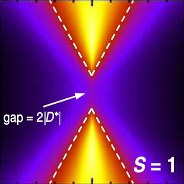Spintronic Magnetism
Quantum dots embedded in spin-valve structures require a description that goes beyond the standard concepts of charge- and spin-currents. One key quantity that arises when going beyond conventional spintronics theories is the spin-quadrupole moment.
Two new effects are related to this quantity: coherent quadrupolar renormalization terms and dissipative accumulation of an average spin quadrupole moment. These can be roughly considered as analogs of the spin-torque and the spin-accumulation and are required when describing interacting multi-spin systems. In fact, this makes high-spin quantum dots in spintronic setups behave very much like molecular magnets with intrinsic magnetic anisotropy, but with various new possibilities for tuneability.
Spintronic Magnetic Anisotropy – Quadrupolar Renormalization
Single-molecule magnets and some magnetic adatoms exhibit strong spin-anisotropy, stabilizing the two axial spin states “up” and “down” with respect to all partially planar spin states. This energy splitting of the high-spin ground-multiplet comes about by virtual spin-orbit scattering into the excited multiplets with non-zero orbital moment.
In spintronic circuits a high-spin quantum dot can acquire the same spin-anisotropy term in its Hamiltonian without any spin-orbit coupling in a very similar way, namely by virtual tunneling of the electrons into electrodes with a non-zero spin-polarization, e.g. ferromagnets. These processes generate a “spintronic magnetic anisotropy” that is tuneable by electrical gates, by the absolute and relative polarizations of the ferromagnets and by the tunnel coupling.
M. Misiorny, M. Hell and M. R. Wegewijs, Nature Physics,
DOI: 10.1038/nphys2766
(M. Misiorny, M. Hell, M. R. Wegewijs)

Spin-Quadrupole Currents and Accumulation
In spintronic circuits a high-spin quantum dot can accumulate a non-zero spin-quadrupole moment by dissipative transport of spin-spin correlations. Responsible for this are spin-quadrupole currents describing the “flow” of spin-anisotropy. This is similar to the generation of an average spin-accumulation due to spin-currents. However, the multi-particle nature of spin-quadrupole transport requires a complete reformulation of the transport problem and a careful rethinking of basic concepts and an analysis of elementary spintronic setups, such as the Julière spin-valve model. For instance, a finite spin-quadrupole current can appear even for zero spin current.
M. Baumgärtel, M. Hell, S. Das, and M. R. Wegewijs, Phys. Rev. Lett., 107, 087202 (2011)
M. Hell, S. Das and M. R. Wegewijs, Phys. Rev. B, in press (2013)
(M. Hell, M. R. Wegewijs)

